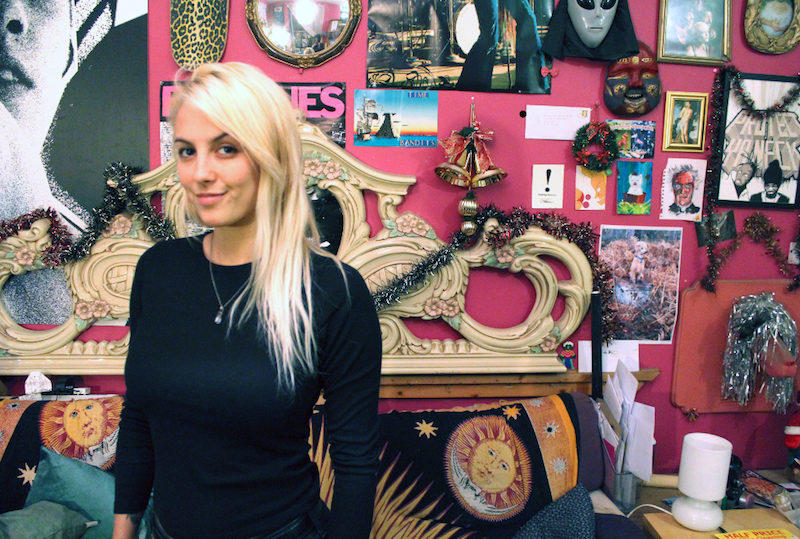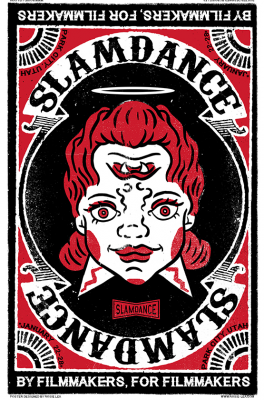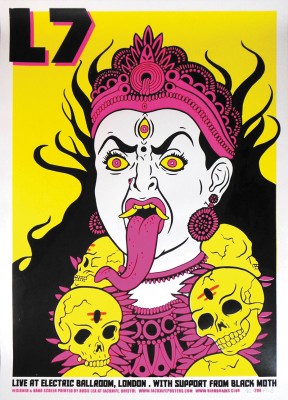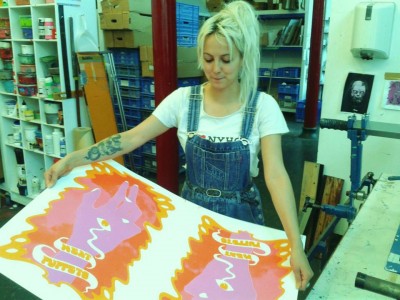Impossible to Ignore: Slamdance 2016 Artist Rosie Lea
Art
Each year, the Slamdance Film Festival, which emphasizes the creative force of emerging and independent filmmaking, enlists a featured artist to contribute their work to the showcase. For 2016, Slamdance chose to present the graphic art of Bristol, UK–based screenprinter and illustrator Rosie Lea.
Slamdance is founded on a rebellious, unapologetic ethos as well as a mission that aims to showcase and foster alternative arts and culture. Like the spirit of Slamdance, much of Lea’s work, which consists largely of bold prints and gig posters, centers around the unexpected and subversive—as well as a bit of the diabolical. “It’s good to be involved with Slamdance,” says Lea. “I prefer the independent side of the arts, and the general DIY, punk and experimental nature of screenprinting—especially the carefully considered aspect of hand printing—is what initially drew me in.”
The 2016 festival’s “Saints and Sinners” theme was the ideal platform for Lea’s style, which traverses thick black lines, loud, flat colors, a punk-meets–pop art–meets-surrealist aesthetic, and a particular penchant for close-up faces bearing suggestive expressions. “In our showcase, you’ll always get plenty of surprising, offbeat characters,” says Peter Baxter, President and Co-founder of Slamdance.
“Some are the best of the best, some the worst of the worst, and then there’s more holding duplicitous surprise. We wanted the new artwork to reflect these and also Slamdance as a whole: We’re not perfect—we get into trouble. Yet, Slamdance is bolstered by the saintly goodwill of its programmers, filmmakers and partners alike.”
With Baxter’s art direction, Lea’s completed Slamdance poster brings together angel and demon, conjoined into a single head with two faces: one smiling with short pigtails and long eyelashes, the other bearded and fanged. “The basis of good collaboration is trust and communication,” says Baxter. “Once you’ve communicated what you want, get out of the artist’s way and completely trust their work.”
Referencing medieval manuscripts, vintage matchboxes and optical illusions, Lea added a mischievous and more digitally involved flair: The head spins back and forth between the two faces. “[Lea’s] work is playfully interactive and lets you decide whether you’re good, bad or both at the same time,” says Baxter. “Look one way, you see an angel. Look the other, a demon. Depending on how you see the image, or with one quick turn, you’ll go from saint to sinner and then back again.”
Despite having only been in the screenprinting business for a couple of years, Slamdance is but one of several impressive clients in Lea’s portfolio. Lea has created gig posters for the likes of Swans, Eagles of Death Metal and one of her personal favorites, L7, for which she drew an especially fierce rendition of the Hindu goddess of empowerment, Kali, replete with a snakelike tongue, unforgiving gaze and massive necklace of human skulls, all printed in hot pink and yellow ink.
When prodded about her dream client, Lea doesn’t have anyone specific in mind—L7 was pretty high up there for her—but, she admits a little sheepishly, she’d like to do a poster for Aerosmith, “Though that would just be a fangirl thing,” she says. “It was always second nature to be doing something creative,” says Lea. “I’ve always been drawing and illustrating, but screenprinting has really been what I feel most comfortable doing, what I can most express myself through.” She recalls growing up with punk rock parents and having zines and graphic novels all throughout the house: “My dad was always in a band or drawing a comic, and my grandma—well, she wasn’t punk rock, but she was constantly getting me to make things,” says Lea.
Paired with Lea’s creative bearings, the independent spirit captured by Lea’s work permeates Lea’s process, which combines the tactile nature of hand printing with artistic instinct. While some of her commissioned projects do involve art direction—including her Slamdance poster—gig poster designs are generally left entirely up to her creative discretion, which presents her with thrilling artistic freedom as well as a challenge: When she’s listening to a band she’s excited by or familiar with, such as L7, it’s much easier for a vision to come to life, but that isn’t the case when it’s with a band she’s less interested in.
After formulating each of her visual concepts, Lea drafts her print’s centerpiece by hand before digitally manipulating and converting the designs so that they can be meticulously hand-cut and then hand-printed. The ensuing step—the selecting and mixing of the vivid, almost-clashing colors so emblematic of Lea’s work—seems to come just as instinctively as the initial concepts often do.
Given the continued popularity and prevalence of graphic art, that sense of intuition is important. “I try and keep my work quite personal,” says Lea. “My favorite artwork always tends to show that connection, those ties between a person and their art.”
As an artist and maker, Lea never stops learning. Her favorite posters are typically also her most recent because with each new project, Lea continues to develop and refine certain aspects of her process and style. Since she first started, Lea has become more careful during the print process with her registration—how precisely her designs are aligned.
She’s also tried to focus more on the graphic design of a poster as a whole—how each illustration interacts with the textual elements, for example—rather than simply “slapping an illustration on a piece of paper,” she says. Just as Slamdance gave Lea the opportunity to incorporate a turning, interactive face into her design, each new project affords Lea the chance to further experiment with her medium.
Recently, Lea’s been toying with printing on shiny, holographic foils, and last Halloween, Lea produced several spooky prints on mirrors for the “Adult Hex Shop,” a Bristol exhibition themed around Halloween coupled with a sex shop.
When it comes to inspiration, Lea is constantly pulling influences for her works from a massive array of genres, artists and styles. She cites a few favorites: Jaime Hernandez’s alternative comic book, Love and Rockets; Nightmare on Elm Street; writings by Charles Bukowski and Raymond Carver; Seattle-based hardcore punks The Fartz. “I have a ginormous notebook full of ideas and sketches,” says Lea. “It’s got stickers, photographs I take, things I find.
I’ve got loads of comics and books on weird stuff—like a collection of vintage wrapping paper—that I flip through to find colors that catch my eye.” Lea says she’s a fan of virtual reference material, too, by way of Tumblr and Pinterest: “I found a blog the other day that was just ’70s sci-fi art, which is brilliant,” she says.
Lea produces and exhibits work as part of Bird Brains, a two-person collective featuring Lea and her boyfriend, Andy, who helped guide Lea when she first started getting into screenprinting after her various university forays into creative writing and, more briefly, fashion. Lea is also a member of Jacknife Prints, a Bristol-based screenprinting studio consisting of what Lea describes affectionately as a “gang of artists.” “We do our own independent work, but it’s nice to have that social aspect—to have an art collective to attend conventions and present exhibitions with,” says Lea. She and the Jacknife gang have traveled around the world with their work—their next venture to the States will be for Flatstock, an annual convention of the world’s top gig poster artists presented in conjunction with Austin’s SXSW.
As she continues to grow as an artist and screenprinter, Lea hopes to create more art prints and continue experimenting with the medium, which might include using ultraviolet inks, printing on new materials—“You can print on virtually anything,” Lea says—and exploring more full-color printing methods, such as CMYK, a process that involves separating a file into four different colors to reproduce an image.
There’s the ultimate dream, too, of creating a graphic novel, sparked, perhaps, by Lea’s comic-filled upbringing along with her enchantment of Hernandez’s excellently crafted universe in Love and Rockets. “Forever, I’ve had this idea of producing a graphic novel,” says Lea. “That’s something I really, really want to do. I studied creative writing; I do all the drawing; I’ve written a couple of comics—I think a graphic novel is what I want to be that perfect thing, that thing I make best.”
The stories Lea wrote as a creative writing student were always based around life stories, but she doesn’t have a concrete narrative in mind for her graphic novel yet—just a lot of ideas, typed spontaneously into her phone or compiled continuously into her notebook. “I’m always adding to that ginormous notebook,” Lea says, “but I feel a bit shy about revealing those ideas.”
Until we get the chance to read and flip through her finished graphic novel, however, we do get to see Lea’s striking prints and their highly stylized illustrations, dramatic color and fantastical subject matter. Lea’s works feel spectacularly dynamic and electrifying, breathing new life into an art form that embodies the long-lived and heavily embraced traditions of counterculture. After all, as Lea puts it, so much of her art and what she aims to create “is a matter of putting together something that immediately catches your eye—something you just can’t ignore.”
To stay up-to-date with Lea’s work and to purchase her prints, visit rosie-lea.com. For more information about Slamdance Film Festival 2016, visit slamdance.com.




